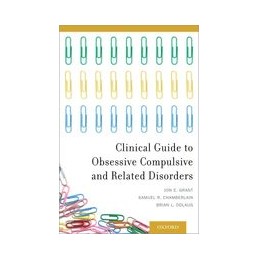Opis
Clinical Guide to Obsessive Compulsive and Related Disorders is a complete, comprehensive overview of OCD and related disorders (trichotillomania, excoriation disorder, hoarding disorder, body dysmorphic disorder, and tic disorders). The book covers underlying causes, clinical presentations and treatments. The book serves as a primer for clinicians in training and those already in practice who have little if any background in these disorders. It discusses thepharmacological and psychosocial treatments for both adults and children with an emphasis on providing practical information for clinicians to use in their everyday practices. Based on the DSM-5, the book uses the latest evidence-based information regarding treatments including medication options, behavioral therapies,alternative treatments, and recent developments in surgical treatment. This book will provide students, residents, interns and even veteran clinicians with a basic understanding of OCD and disorders that are often associated with OCD. In addition, members of the public and those affected by these disorders may use this book to enhance their personal knowledge of the subject matter presented.
Szczegóły produktu
Indeks
87596
EAN13
9780199977758
ISBN
9780199977758
Opis
Rok wydania
2014
Numer wydania
1
Oprawa
miękka foliowana
Liczba stron
274
Wymiary (mm)
140 x 210
Waga (g)
318
PART I: Overview and Evaluation; Chapter 1. Overview; Overview of Obsessive Compulsive Disorder; Overview of Related Disorders; Epidemiology and Etiology; Diagnosis and Comorbidity; Treatment; References and Further Reading; Chapter 2. Evaluation and Treatment Planning; General Aspects of an Evaluation; OCD Patient Interview; Standardized Instruments; Family Evaluation; Medical Evaluation; Treatment Planning; PART II. Obsessive Compulsive and Related Disorders; Chapter 3. Obsessive Compulsive Disorder; Clinical Description; Diagnosis; Comorbidity; Course and Prognosis; Differential Diagnosis; Monitoring Treatment; Treatment; Pharmacotherapy (Indications/Efficacy, Initiation/Ongoing Treatment, Risks/Side Effects); Psychotherapy; Treatment of Common Comorbid Disorders; Chapter 4. Hoarding; Clinical Description; Diagnosis; Comorbidity; Course and Prognosis; Differential Diagnosis; Monitoring Treatment; Treatment; Pharmacotherapy (Indications/Efficacy, Initiation/Ongoing Treatment, Risks/Side Effects); Psychotherapy; Treatment choice and sequencing of treatment; Chapter 5. Body Dysmorphic Disorder; Clinical Description; Diagnosis; Comorbidity and Sequencing Treatment; Course and Prognosis; Differential Diagnosis; Treatment; Psychotherapy; Pharmacotherapy (Indications/Efficacy, Initiation/Ongoing Treatment, Risks/Side Effects); Treatment choice and sequencing of treatment; Chapter 6. Hypochondriasis; Clinical Description; Diagnosis; Comorbidity; Course and Prognosis; Differential Diagnosis; Monitoring Treatment; Treatment; Pharmacotherapy (Indications/Efficacy, Initiation/Ongoing Treatment, Risks/Side Effects); Psychotherapy; Treatment choice and sequencing of treatment; Chapter 7. Trichotillomania (Hair Pulling Disorder); Clinical Description; Diagnosis; Differential Diagnosis; Comorbidity and Sequencing Treatment; Course and Prognosis; Treatment; Pharmacotherapy (Indications/Efficacy, Initiation/Ongoing Treatment, Risks/Side Effects); Psychotherapy; Treatment choice and sequencing of treatment; Chapter 8. Excoriation (Skin Picking) Disorder; Clinical Description; Diagnosis; Differential Diagnosis; Comorbidity; Course and Prognosis; Treatment; Psychotherapy; Pharmacotherapy (Indications/Efficacy, Initiation/Ongoing Treatment, Risks/Side Effects); Treatment choice and sequencing of treatment; Chapter 9. Tic Disorders; Clinical Description; Comorbidity; Course and Prognosis; Differential Diagnosis; Monitoring Treatment; Treatment; Pharmacotherapy (Indications/Efficacy, Initiation/Ongoing Treatment, Risks/Side Effects); Psychotherapy; Treatment choice and sequencing of treatment; Part III: Special Clinical Considerations; Chapter 10. Special Issues in Treatment; Treatment-Resistant cases; Pharmacotherapy Issues for Children and Adolescents; General principles; Developmental Toxicity; Indications and Dosages; Outcome; Adherence to Treatment; Alternative Treatments; Indications and Efficacy; Initiation and Ongoing Treatment; Risks and Side Effects; Hospitalization, Day Treatments, and Residential Treatment; Neurosurgery for Obsessive Compulsive Disorder; Chapter 11. Special Clinical Circumstances; Obsessive Compulsive Disorder and Substance Addiction; Obsessive Compulsive Disorder in Developmentally Disabled Individuals; Obsessive Compulsive Disorder with Poor Insight; PANDAS/PANS; Appendix. Resources for Patients and Their Families; Suggested Further Reading; Resources; Scales;


 Dostawa
Dostawa
 Płatność
Płatność
 Zwroty
Zwroty
